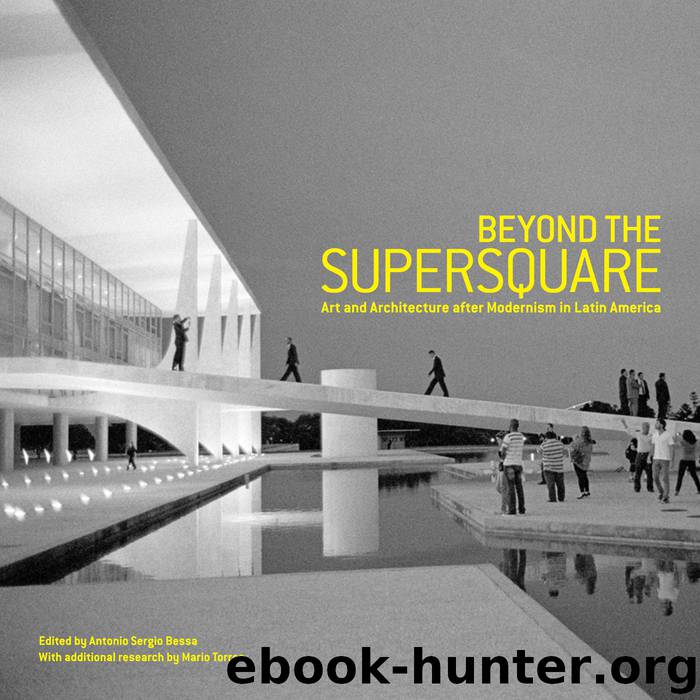Beyond the Supersquare by Antonio Sergio Bessa

Author:Antonio Sergio Bessa
Language: eng
Format: epub
Publisher: Fordham University Press
Published: 2014-03-13T04:00:00+00:00
Notes
1 / Carlos Alberto F. Martins, “Hay algo de irracional...,” Block, no. 4 (December 1999): 8–22; Jorge Francisco Liernur, “The South American Way,” ibid., 23–41; Ana Maria Rigotti, “Brazil Deceives,” ibid., 78–86; Maria Beatriz C. Cappello, “Arquitetura em Revista: arquitetura moderna no Brasil e sua recepção nas revistas francesas, inglesas e italianas (1945–1960),” PhD dissertation, FAUUSP, São Paulo, 2006; Nelci Tinem, O Alvo do Olhar Estrangeiro: o Brasil na historiografia da arquitetura moderna, João Pessoa: Ed. Universidade Federal da Paraíba, 2006; Monica Junqueira, “Brazilian presence in the historiography of Twentieth Century architecture,” Docomomo Papers, no. 34 (March 2006): 66–71.
2 / Phillip Goodwin, Brazil Builds, Architecture New and Old, 1652–1942 (New York: MoMA, 1943); Lucio Costa, Arquitetura Brasileira (Rio de Janeiro: Ministério da Educação e Saúde, 1952); Henrique Mindlin, Modern Architecture in Brazil (Rio de Janeiro/Amsterdam: Colibri, 1956); Yves Bruand, L’architecture contemporaine au Brésil, PhD dissertation, Université Paris IV, 1971; Paulo Santos, Quatro Séculos de Arquitetura (Rio de Janeiro, Valença, 1977); Carlos Lemos, Arquitetura Brasileira (São Paulo: Melhoramentos/EDUSP, 1979); Adrian Forty and Elisabetta Andreolli, eds., Arquitetura Moderna Brasileira (London: Phaidon, 2004).
3 / David Underwood, Oscar Niemeyer and the Brazilian Free-form Modernism (New York: Braziller, 1994).
4 / Alan Hess, “The Sensuous Modernist,” in Oscar Niemeyer Buildings (New York: Rizzoli, 2009).
5 / Cf. Peter Buchanan, “Floating form, fluid space: the poetics of Oscar Niemeyer,” ArqTexto, nos. 10–11 (2007): 6–19; Fares El-Dadah, “Niemeyer: sem retas” and Hanno Rautenberg, “O ultimo utópico: por que Niemeyer apostou numa arquitetura da liberdade,” in Tributo a Niemeyer, ed. Roberto Segre (Rio de Janeiro: Viana e Mosley, 2009).
6 / Luiz Carlos Daher, Flavio de Carvalho e a volúpia da forma (São Paulo: Editora K, 1984); J. Toledo, Flavio de Carvalho: o comedor de emoções (Campinas: Editora da Unicamp/São Paulo: Brasiliense, 1994); Carolina Rossetti, Flávio de Carvalho: questões de arquitetura e urbanismo (São Carlos, SP: EESC-USP, 2007).
7 / Flavio de Carvalho, “A cidade do homem nú,” Architectura: mensário de arte, no. 14 (August 1930); Flavio de Carvalho, “Uma these curiosa,” in Diário da Noite, São Paulo, July 1, 1930.
8 / Flavio de Carvalho, A cidade do homem nú (São Paulo: Museu de Arte Moderna de São Paulo, 2010), 21.
9 / Ibid., 29.
10 / Ibid., 27.
11 / Ibid., 25.
12 / Ibid., 27.
13 / Ibid., 28.
14 / Benedito Nunes, Oswald Canibal (São Paulo: Perspectiva, 1979).
15 / Aracy Amaral, Blaise Cendrars no Brasil e os Modernistas (São Paulo: Ed. 34/Fapesp, 1997); Alexandre Eulálio, A Aventura Brasileira de Blaise Cendrars (São Paulo: EDUSP/Imprensa Oficial, 2001).
16 / Le Corbusier, L’Art decoratif d’aujourd’hui (Paris: Arthaud, 1980), 22.
17 / Le Corbusier, Précisions sur un état present de l’architecture et de l’urbanisme (Paris: Fondation Le Corbusier/Altamira, 1994), 17.
18 / Fernanda Peixoto, “Lévi-Strauss no Brasil: a formação do etnólogo,” Mana 4, no. 1 (April 1998): 79–107.
19 / In France, since the end of World War I, a connection between anthropology, art, and activism had been paved both by the ethnographic surrealists and the first generation of academic ethnologists, including George Bataille, Michel Leiris, Marcel Griaulle, Paul Rivet, and Alfred Métraux.
Download
This site does not store any files on its server. We only index and link to content provided by other sites. Please contact the content providers to delete copyright contents if any and email us, we'll remove relevant links or contents immediately.
Kathy Andrews Collection by Kathy Andrews(11726)
The remains of the day by Kazuo Ishiguro(8815)
Paper Towns by Green John(5086)
Spare by Prince Harry The Duke of Sussex(5071)
The Body: A Guide for Occupants by Bill Bryson(4973)
Industrial Automation from Scratch: A hands-on guide to using sensors, actuators, PLCs, HMIs, and SCADA to automate industrial processes by Olushola Akande(4969)
Machine Learning at Scale with H2O by Gregory Keys | David Whiting(4167)
Be in a Treehouse by Pete Nelson(3939)
Never by Ken Follett(3786)
Harry Potter and the Goblet Of Fire by J.K. Rowling(3771)
Goodbye Paradise(3724)
Into Thin Air by Jon Krakauer(3307)
The Remains of the Day by Kazuo Ishiguro(3291)
The Cellar by Natasha Preston(3258)
The Genius of Japanese Carpentry by Azby Brown(3221)
Fairy Tale by Stephen King(3216)
120 Days of Sodom by Marquis de Sade(3176)
Drawing Shortcuts: Developing Quick Drawing Skills Using Today's Technology by Leggitt Jim(2996)
The Man Who Died Twice by Richard Osman(2995)
